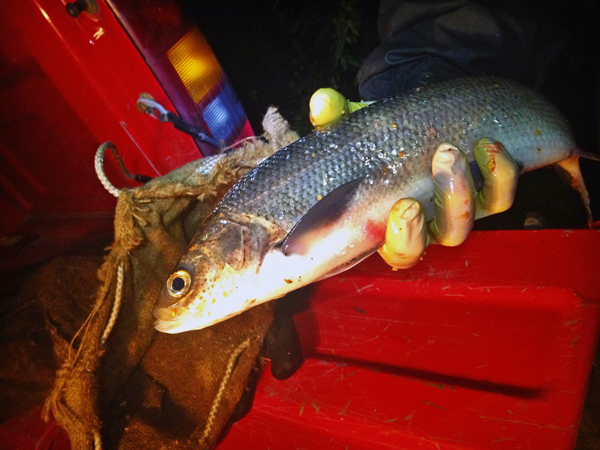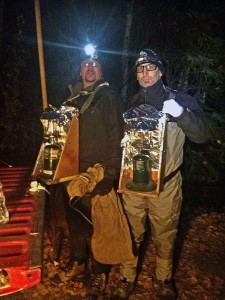
For one month each fall, Interior residents wade into the crystal clear waters of the Chatanika River to catch whitefish.
They spawn in the fall, unlike other fish in Alaska.
The state limits both the number of permits and the harvest. This isn’t your typical fishery. Instead of rods and reels, or nets, fishermen use spears.
Whitefish are one of Alaska’s most common species.
“Oh! There’s one right in front of me. Come on Emily Schwing, get this one,” I said, as one came into view. “Oh! I missed him.”
I’m getting a lesson in spear fishing and so far, things aren’t going so well. Lifelong Fairbanksan Cory Kuryla gives me some pointers.
“You’re going to want to hold your spear under the water and you want to move as slowly as you can towards them and then give it a little pop,” Kuryla said.

We stand waist deep in the Chatanika River holding eight foot long spears. Kuryla has been catching whitefish this way all his life.
“I’ve had a lot of good times here, a lot of good times on this river,” he said.
He remembers when people would line their boats up along the riverbank to pull whitefish from the crystal clear waters.
Area Management Biologist Audra Brase says, in the 1980’s, the fishery was huge.
“It was unrestricted; they could just get as many fish as they wanted,” Brase said. “Then a cap was put on it – a 15 fish per day limit.”
“People were still harvesting I mean thousands and thousands of whitefish were pulled out. I wasn’t here at the time, but I understand people would take bushel baskets full of ‘em.”
But overfishing led to a population decline and the fishery closed in 1992. It reopened in 2007, and now it’s much more restricted, with a limited number of permits and a limited harvest. On top of that, Brase says whitefish are hard to catch.
“If you try to catch a fish on hook and line, it’s difficult. So doing a spear fishery is the only way to get them if you want to harvest whitefish to eat,” Brase said. “Another interesting thing about these whitefish is that they’re really old.”
They can live up to 15 years, and unlike other species, they spawn again and again every fall, but only at night. The darkness mixed with the brisk autumn temperatures may deter some fishermen, but not Cory Kuryla. His tried and true methods solve both problems.
He lights a Coleman lantern. It sits in a wooden box that’s open in front. The whole thing hangs from my neck. As we wade, waist deep into the cold river, the lanterns hiss.
Wearing this contraption comes with a warning from Kuryla and his best friend Dave Ensley.
Kuryla: “You’ve got to remember, do not get water on that glass. It can explode, because it’s so hot.”
Ensley: “You get excited and you’ll want to lunge full way forward and you’ll dip the lantern in the water trying to get that fish.”
Kuryla: “Don’t do that.”
The yellow light from the flame will help us see the fish. We can’t use LED headlamps because that white light doesn’t shine though the water the same way, but, there’s still one other challenge.
Schwing: “You have to train your eyes to look for them.”
Kuryla: “Oh you sure do. There’s one!”
Kuryla has years of experience, so the water doesn’t throw his depth perception off like mine. But finally…
Schwing: “Yes! I got him.”
Kuryla: “Ok, pick him up. Sweet!”
Schwing: “Nice!”
Kuryla: “OK!”
We pluck the silvery fish from my spear and drop in a burlap bag that hangs from my shoulder. After nearly two hours, we’re cold enough to call it a night. Kuryla says there’s only one more thing I need to know.
“We make rookies take a bit out of the first fish they catch!” Kuryla said.
Lucky for me, my one fish floated out of my burlap bag somewhere along the river.




